
We are pleased to announce that Monroe Robinson (shown above) is hosting Open Wire this Saturday. NB: He’s a time zone or three behind us – so you might have to wait for answers. But don’t wait to post your questions – we’ll still open things up by 8 a.m. EDT, and cut off comments at 5 p.m. EDT)
When I volunteered to be a part of Open Wire, I thought it would be interesting and fun to answer questions about Dick Proenneke, including aspects of his life not included in “The Handcrafted Life of Dick Proenneke.” But when Chris asked me to write a few lines about what I’m currently working on, I realized I had an opportunity to include your ideas in a conversation I am having with myself and others about using tropical hardwoods.
First, a quick life update: My wife, K. Schubeck, and I spend most of our hours during the summer caring for what lies beyond our house and my shop, planting and harvesting our garden, caring for the many flowers, flowering trees and shrubs, picking berries and fruit to freeze, juice or jam. I am trying to perfect the making of intensely flavored jams with little added sweeteners. With each passing year I find myself seeking to share life’s experiences with family, friends and community rather than working by myself.
In September, my friend, Lou Krukar, will visit from Washington to help me make four large dining tables from the most beautiful planks of old-growth redwood I brought out of the forest in the 1990s.
The planks are eight book-matched pieces that were part of a 21’ log that sunk in a local river between 1850 and 1875, when trees were felled with axes and pulled to the river bank with oxen. This log sank on its way to the Big River sawmill and was covered in mud until I pulled it free. The bottom 9’ of the log is wavy grained leaving 12’ of straight and clear redwood above. This will be a collaborative project. First we will crosscut the planks and bring them into my shop to dry under metal roofing. When Lou returns a few months later, we will work on the tables and he will take one home.

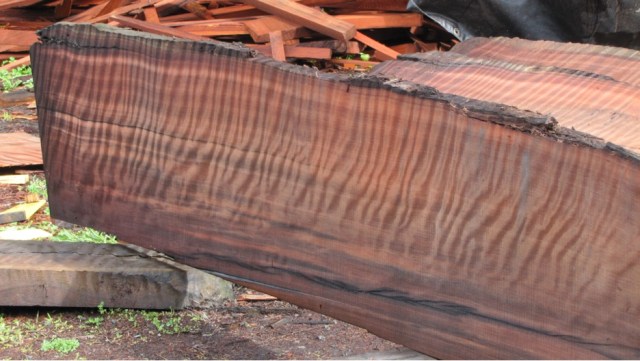
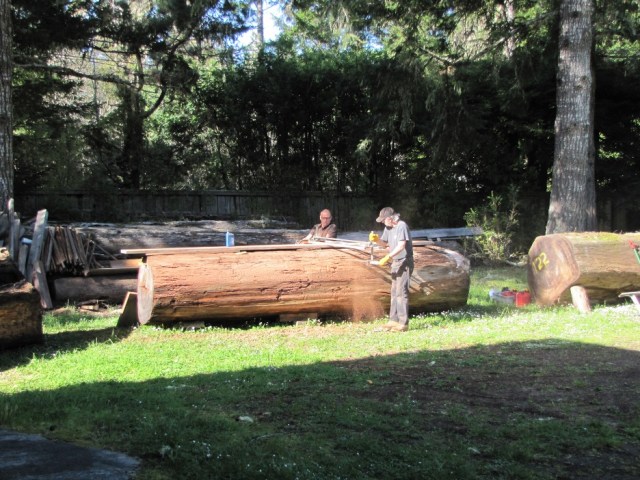
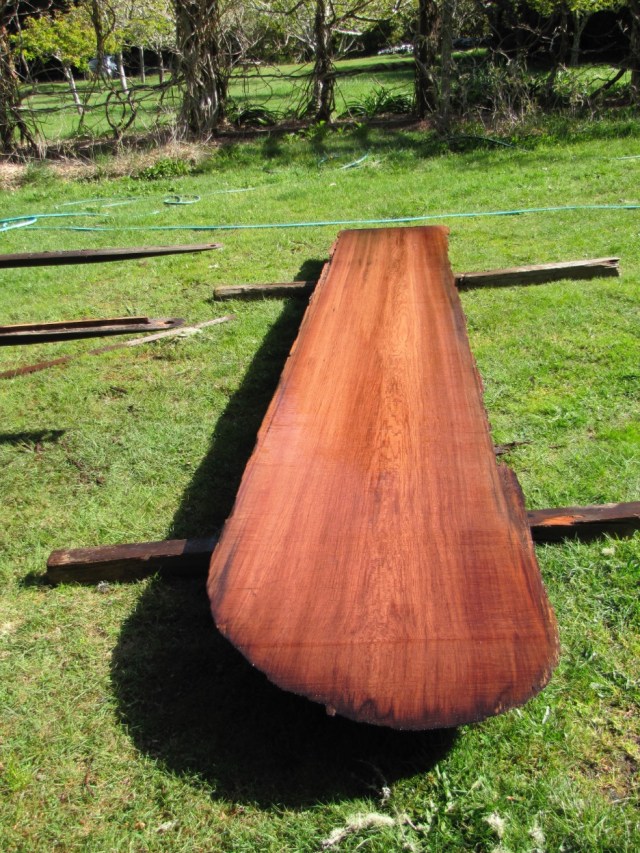
On the first day I removed a salvaged old-growth redwood log from the forest in 1992, my partner Roger Moore and I made a commitment that working in the forest would be give and take. I have no reservations of my having lived up to that commitment and am honored to still have many timbers from that dangerous yet special experience. But lately I have been trying to determine the best way to use up a few pieces of precious wood I purchased decades ago, from a place and in a manner that no longer fits with my values. And I am certain I am not the sole craftsperson in this position.
While I attended The Krenov School during its third and fourth years, Jim Krenov spoke a few times about his use of fine woods from around the world. He thought of himself as a single person who used limited amounts of precious woods in the creation of sensitive furniture that honored the wood he used. At the time, I felt as if this interpretation opened the door for my own use of tropical woods. While in the program I made a China hutch from Honduras rosewood (pictured in the introduction of my book) along with a shop-sawn veneered 58” circular dining table with four 12” leaves to match. The two pieces were in the student show at the end of my second year and resulted in my building a similar table for a client. When working up a proposal, I ended up purchasing some wood samples, including cocobolo, Thai rosewood, Andaman padauk and ebony. The client commissioned a 58” circular ebony dining table with eight 13” leaves, 18 folding ebony chairs with hand-caned seats and backs, and a 9’ buffet table that cantilevered from their adobe wall.

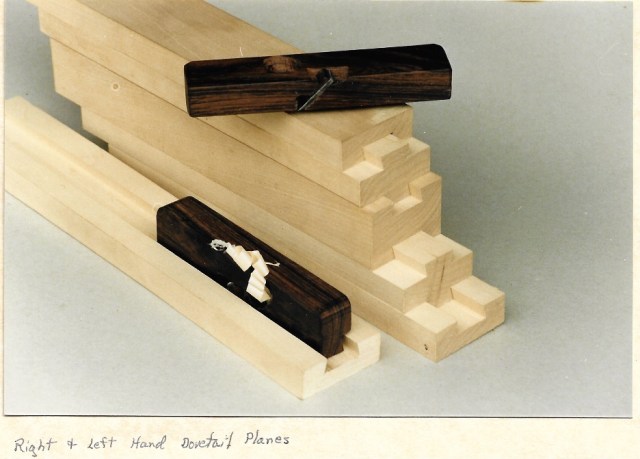
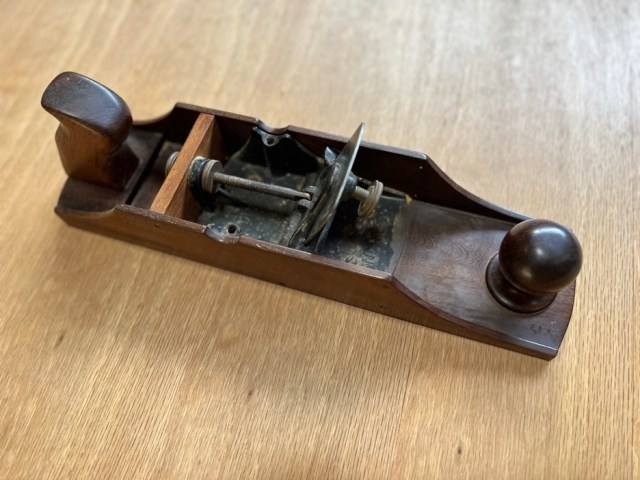
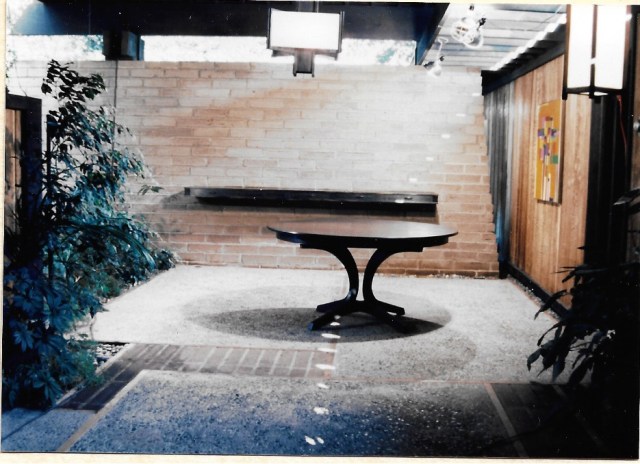
When I built the ebony dining set, I was also writing articles for Fine Woodworking and teaching a few gigs around the country. I realized I did not want to encourage the use of endangered hardwoods.
I came up with a plan: The retail cost of ebony cost accounted for 10 percent of the entire dining set. I decided I would be willing to build furniture with tropical hardwoods only if I added 10 percent more to the price, which I would then donate to a conservation organization close to the wood’s place of origin. However, future conversations about the impact of tropical wood extraction were enough to sway every client’s interest away from the use of such woods. As such, I have used only local woods for the past three-and-half decades.
That ebony from the Celebes Islands was the last tropical hardwood I purchased. But those samples? They still reside, untouched, on my lumber rack.
As a very young child, I could never understand how people killed almost every buffalo on the plains. What did that do to the people who depended upon them for survival? I wondered. I have maintained a commitment to never be a part of something like that. And yet, despite my convictions, I now find myself having been part of a tragedy of even greater magnitude for the world’s environment and possibly our own survival.
Creating surfaces from beautiful woods has always been what excites me most about working with fine wood. Everything I do beyond that supports the expression of that surface. I have enough of each of the sample woods I’ve mentioned to create a sizable buffet table. I plan to collaborate with a friend, Doug Carmichael, to make a wrought iron base for at least a table or two. Another friend, Tony Perelli, will make two candle holders and a set of hors d’oeuvre saucers to live with each table. Once my friends are compensated I plan to donate at least 50 percent of what remains of the selling price to conservation in the country of the wood’s origin.
Here are some of my questions: Is it possible to get a permit to sell a piece of rosewood furniture even though I no longer have the original invoice? I wish I had never purchased this wood, but I can’t undo what I’ve done. Making something beautiful, to be owned with reverence and knowing that the profit goes to conservation, is the best I can think to do. Any suggestions?
And now I look forward to answering your questions as well!
Finally, if you wish to keep in touch, my email is monroe@mcn.org.


I would almost be tempted to find a way to repatriate the wood to craftsmen from the regions affected; but that also seems infeasible.
I love the idea of repatriation of precious woods… for use by a local craftsperson but the cost and logistics seems impossible. Conservation groups within the redwood forest region are doing a stellar job of both purchasing remaining old growth redwood land and obtaining conservations easements where possible and this is only possible when they receive donations. I hope international conservation agencies are as effective in preserving tropical rainforest I’ve witnessed locally.
That curly redwood is fantastic!
I look forward to reading your Q&As Monroe.
I’ve never used much exotic wood, aside from turning a lot of tool handles. It was interesting to see their different qualities. That was quite some time ago. My only recent experience, a few months back, resulted in a pretty severe allergic reaction to cocobolo, which never bothered me in the past. Twice since I’ve had bad reactions, no doubt to encountering some small trace of the dust in what I was sure was a very clean shop. Never again.
I have only made a couple of hand planes from cocobolo and did not have an allergic reaction… but have heard cocobolo’s reputation. The last month creating the dining set of Honduras rosewood… I became progressively more allergic. I suspect rosewood species in general may create allergic reactions… cocobolo maybe being the worst.
Looking forward to the Q&A this Saturday. Ever since Chris mentioned (had to do with the use of sinker Mahagony I think) many of those sustainably harvested guarantees on the wood are often essentially bogus, I’ve been thinking myself on what can I do myself as a hobby woodworker. I haven’t quite figured out all of the specifics yet. I’m thinking let’s assume I use one tree worth of wood a year (much less in reality, probably I use 100 board feet a year). There must be some legit organization I can donate to that will plant a hardwood tree on my behalf. I can back calculate the survival rate of saplings to get an idea of how many trees I should have planted to “guarantee” on tree makes it to adulthood. The question becomes who is a legit organization that does this and do I like this organization. All good problems to investigate. I could see where it would also be nice if I could plant like for like trees based on what I use.
I’m very impressed with the effectiveness of conservation groups working with the redwood forest along the west coast. But, like you, I do not trust certificates of sustainability and other certificates of good forest practices either within the redwood forest, nationally or internationally. They do seem bogus.
Tree people in Los Angeles might be a good place to start: https://www.treepeople.org
Thanks Mike. I will start there. I am sure I will find someone somewhere who will give me the warm fuzzies about the way they are doing it.
Ask Shannon Rogers about the legality of the use of rosewood. He runs The Hand Tool School, is Renaissance Woodworker on YouTube, one of the hosts of Wood Talk, and the host of Shannon’s Lumber Industry Update. He’s done several episodes on the use of endangered and CITES listed woods and chain of custody and so on. My understanding of it legally is that yes, you can. He would know a lot more about it, though.
Thanks, Shannon Rogers’ episode #7 is a good introduction to CITES.
For Shannon’s sake, I’m going to throw a strong “allegedly” in there. He’s not a lawyer, I don’t think, nor am I. So for anything he says, take it as his understanding (as a very knowledgeable person) of the legality of the issues at hand. His is by no means is the final word on the matter. Merely another voice to consider. You’re welcome, Shannon, if you read this. Haha
I’m glad we live in an era where people are finally waking up and the idea of sustainability, and using resources responsibly is becoming the norm. we can’t change the past. i hope you do find a way to use what you have. to me, it’s as much of an injustice to destroy the resource that was most likely legally harvested (before we knew better). better to use it, enjoy it, honor it with a long life in a form made with love. using it isn’t the problem, it’s using it to extinction and wasting it that is. i hope we can all find a way to have legitimate sustainability. until then, we use what we have and wait to buy more until they figure it out.
Wow are those logs beautiful!!!
I don’t know if you can get a permit to make this furniture, but I think that it would be ethical to do so.
You worry, appropriately, that making a piece from this lumber could send the wrong message to the world: “cut down more exotic trees to make more pretty furniture like this.” So get in front of that message. When describing the piece, talk about the tragedy of deforestation and the need to restore tropical forests. Tell the buyer to preserve the piece and the message together, and to do so with, as you say, reverence.
I’m looking at that redwood log and the resulting wet boards in absolute awe. There is nothing about the piece, the work, and (I am sure) the resulting set of tables that is less than beautiful. Thanks for sharing that. As to the tropical woods, I share your skepticism of certificates of origin and so on. My personal (and sadly inadequate) answer is to look at indigenous woods — maples, cherries, walnuts, bois d’arc, cypress, redwoods, oaks and the like.
Wow! Your curly redwood reminds me of some thousand-year-old redwood soundboards I came across a long time ago. I believe they came from a forest that burnt down, so the salvaged pieces were only long and wide enough for very small instruments such as ukuleles. That log you have is amazing. Now I’m day-dreaming about the trees of legends — e.g. The Tree, the mahogany tree from Chiquibul that was 100ft tall and 10ft wide at the base… Imagine!
Have you considered offering/using your curly redwood as tonewood instead of as boards for furniture? Ditto the tropical woods from your stash — ebony can go a long way as fingerboards, tuning pegs, end pins, bow frogs, etc. I recall an interview with Scott Landis where he mentions that wood for musical instruments yields the best return if the purpose is to make the “forest too valuable to burn” and raise the most funds for conservation efforts. CJ Osman of Oregon Wild Wood might be a good person to speak with re: curly redwood.
I’m encouraged by your experience with clients not wanting to use exotic woods once you have a conversation about sustainability. I wish the same were true in the world of musical instruments, especially when it comes to custom-made guitars and ukuleles. I took up building dulcimers because musicians still appreciate simple instruments made by hand using domestic woods such as cherry. Sadly, there’s an emerging demand/supply of dulcimers built using remote tropical woods with bells and whistles only attainable by CNC machines. I’m not a hand-tool purist… I just lament the all-too-familiar race towards a builder/player ecosystem ravenous for exotic wood saturated with hard plastic and polished to a mirror shine.
I’m very much looking forward to Saturday’s Open Wire!
I love to look at the wood of sensitively made guitars and ukuleles. Smaller things of precious woods like knife handles and little parts on a larger project get my attention for their beauty but do not remotely connect me to the unique beauty of what was once a living tree. Thus, it is in the form of table tops, surfaces, not legs or stiles and rails that I love to spend my time making… where I feel reverence as I work.
I’ve had several persons inquire about using my quarter sawn redwood for sound boards. The first spent several hours combing through hundreds of what looked to me like exactly quarter sawn timbers some with grain as tight as 100 growth rings per inch and did not find a single board he wanted. The second person purchased a beautiful board and then once he had cut soundboards said it was not going to yield what he had expected so I reimbursed him for half the price of the board. I have since been reluctant to even show my redwood to anyone interested in soundboards. It does give me a great appreciation for what a discerning guitar maker can see within a piece of wood and know whether it is what they want to work with or not.
I once spent a couple of hours watching Jim Krenov look for wood at a large warehouse in San Francisco. He could see so much in the end grain of timbers within each pile. If the end of a particular plank struck his interest then the two of us would set board aside until one side of a particular board was exposed. And if that timber still had interest then we looked at each side. His actions clearly spoke the depth of what he saw and what I learned. He could intuit what the grain on the surface of curved legs, etc. would be. Decades ago, looking for wood, was the most exciting part of furniture making for me. That is partly why I have ended up with the precious hardwoods that I now I feel responsible to create the projects I saw in those pieces when I purchased them.
In the past 30 years I’m looking at every aspect of an old growth redwood log or a large timber sawn from it and imagine what the next cut will yield. Making projects from random unrelated boards has never held an interest for me. Making projects from timbers or sequential boards sawn from the log brings my imagination into what I am doing… and it is my imagination more than the work itself that feeds my soul.
I like what Sam S. writes about getting in front of the message about cutting more trees to make more beautiful things. What about having a bronze plaque made that affixes to the underside of the table that makes the statement about precious wood, or any wood, ethics, that will always go along with the table.
Hey Monroe
Things change,
When we were young , we were hungry . The rivers were full of fish .
Among the willows , moose and caribou were plenty , we made furniture out of pine boards from shipping crates , and hardwood pallets from behind keni supply in anchorage, you made scrapers from old blades and we set pumps from a home made Derrick driven around on your ford econoline
That was before we all new dick
And now we’re old
We all have a responsibility to leave a few pallets, fish and moose
For the next dick and Monroe that comes along
After 50 years
You set an example of conservation
And inspiration …
Just saying
Things change ,